It is Fine! Everything is Fine. (2007, Crispin Glover, David Brothers, written co- Steven C. Stewart)
Exploitation for a Good

In this day and age of ubiquitous media, where you have many chances and ways of seeing a film (theatrically, on DVD/BD, streamed, as a file download), it is quite a different beast when your only chance of seeing a film is like, tonight at 7 pm. This is the case with one of several films which Crispin (Hellion) Glover screens as part of his travelling road show which includes a slideshow where he functions as a benshi entertaining us with an enthusiastic reading from a selection of his found books (Rat Catching, Oak Mot, etc.), a film, followed by a Q&A and book buying/signing session. That was clearly the draw for me when Glover brought his show to Montreal on January 27 and 28, 2017, at the J.A. De Seve theatre at Concordia University. And better yet, the film was going to be projected on 35mm. The event reminded me of my pre-VHS viewing days, when seeing a film at the theatre was often “a catch me if you can” scenario. And the way I would carefully read and mark up the TV guide for films I wanted to watch. Glover’s modus operandi emulates this earlier screening era by the way he carefully and guardedly protects his property and distribution rights. The films he screens are only ever screened with him in attendance. He travels with his own personal copy of the film print and does not allow ANY photos or filming during his performance. He posts trailers on his website but does not provide screeners or links. So given this “go or miss it forever” decision I ventured downtown to see Glover’s show, which included the main attraction for me, the feature film It is Fine! Everything is Fine! (2007). It is Fine! Everything is Fine! is the second (though screened on the first night) of an intended trilogy, with the first film What is it? screening on the second night (the third film is in production and tentatively titled It is Mine). The film was shot on 16mm blown to 35mm and the print screened was a nice 35mm print, with rich colors and ever present grain and texture.

Steven C. Stewart
It is Fine! Everything is Fine. is a very unique fantasy that gives expression to the frustrations of one Steven C. Stewart, a man born with severe cerebral palsy, who was placed in a nursing room after his mother died when he was in his twenties. Glover leaves ample space after the screening of his films for a Q&A session because his films are designed to trigger emotional responses that require a discourse. Part of his campaign on his road shows is to fight against what he calls the corporate interests in film (and in society in general) that eliminates any kind of controversial or challenging (to your moral, ethical or personal beliefs) discourse. As a famous Hollywood producer once said, “if you want a message, send for western union.” A point to underscore here is the importance of viewing protocol. Glover wants his films to spark a certain kind of shocked reaction and then debate and discourse. But in another viewing protocol context his films may not shock as he intends. For example, the theatre Glover presented in, the J.A. De Seve theatre, is also one of the venues for the Fantasia International Film Festival, and the Fantasia audience is infamous for being able to withstand all manner of shock and react in an abrasive way, often laughing at sensitive material as a type of defense mechanism or form of bravado. Hence if It is Fine! where to play at Fantasia audiences may laugh at inopportune moments during scenes of violence, sex, or social awkwardness or embarrassment, which could derail the sort of serious discourse Glover encourages. Hence to some extent Glover requires, ironically, a more “mainstream” audience in the sense of being educated and being as equally sensitized to social and political issues as exploitation and esoteric cinema.
One of the issues that It is Fine! Everything is Fine. brings up is the question of exploitation, not in the sense of a genre that was a counter industry strategy to Hollywood (though there is some of that too in Glover’s work), but as something that makes us feel uncomfortable. In the classic period the exploitation masters, producers like David Friedman, Dwain Esper, Russ Meyers, H.G. Lewis, Joe Sarno, or Roger Corman the point was to provide audiences with something they could not get at a first run major studio film, that was usually sex, violence or sex AND violence. There is some of this with Glover, but also a more socially conscious driven agenda. In the case of It is Fine! Everything is Fine. the film is written by and stars Steven C. Stewart, a man born with a severe case of cerebral palsy. Stewart is wheelchair bound and speaks in an almost indecipherable slur, a speech impediment called dysarthria. After the screening we learn from Glover that Stewart lived happily with his mother until she died when he was in his twenties. He was then entrusted to the Mormons who placed him into a nursing home where he was ill treated for ten years. The nursing home did not look beyond the surface appearance of Stewart, calling him an “MR” (mental retard), although Stewart was of average mental capacity. It took Stewart ten years before he was able to move into a more humane living environment, and Glover relates how for Stewart it was a horrible ten lost years of his prime. Glover befriended Stewart and felt sympathy for his plight. Stewart channeled his experiences into art, and would go on to write a screenplay in the style of a 1970s cop TV show, with himself as the lead “villain”: a female serial killer with a fetish for attractive long haired women. There is no doubt that the character played by Steven C. Stewart, Paul Baker, is vile, and that his actions, verging from awkward to sadistic, are misogynist.
The question then becomes, is Glover, even with the best intentions, exploiting the freak factor of having a serial killer who is severely handicapped? (Even if this would not be the first time a physical defect is used as a signifier for gruesomeness or evil, think Rondo Hatton as a killer called “The Creeper” in a series of 1940s thrillers.) Or does the fact that the script is written by a handicapped person circumvent the exploitation? Or does that make it worse (why not just write a more positive character)? Or can we see the depiction of a handicapped killer as a positive, because ‘killers’ are so often the most charismatic or most engrossing characters, like the femme fatales of the 1940s, that finally a person with a real handicap is given such a “meaty” role? Whatever your feelings, it is clear that Glover’s intent is for his film to force the audience to enter into this tricky discourse, where there is clearly no right or wrong answer.
One thing that becomes evident is that the writing and performing of the serial killer character Paul Baker must have been a form of catharsis for the ten years of frustration, abuse, indifference, abandonment and boredom Stewart must have experienced in the nursing home. Though the script may lack a nuance a professional writer may have injected into it, it is an effective expression of Stewart’s rage. Since the film plays out as a twisted sexual fantasy that always ends in death, and sometimes only death and no sex, the female characters end up being the end point of all his frustrations, be they sexual, social or physical. Stewart may have been physically, emotionally or psychologically hurt by men and women, but it is only women who suffer in his film. That’s just the nature of screenwriting, and exploitation cinema. But is It is Fine! Everything is Fine. interesting as a piece of filmmaking? Does it hold our interest? One thing for sure, it isn’t like any other serial killer film, for the simple reason that it does not feel at all like a serial killer film. Stylistically it feels more like a blend of a 1950s melodrama, a Kenneth Anger color psycho-drama and a 1970s cop show. The film is set in Stewart’s home town of Salt Lake City, but the proceedings are given a dramatic and ironic weight by the constant use of classical music, notably Tchaikovsky and Beethoven, sprinkled with the theme from the Sound of Music.
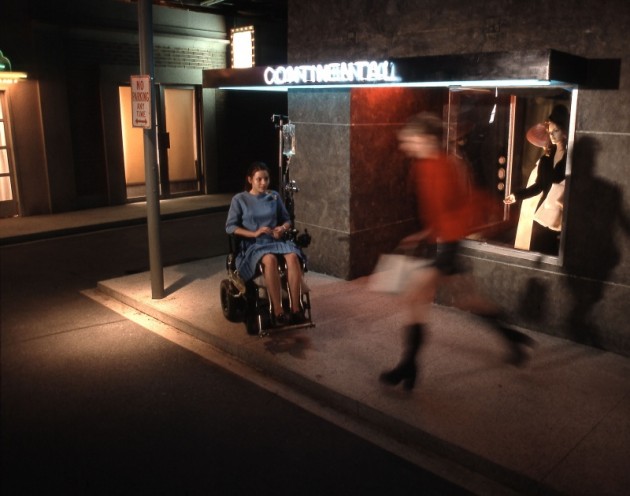
Ruth
In the film Stewart, then about 60 years old, plays Paul, a man with an intense fetish for pretty women with long hair. The film opens with a strikingly framed shot of an old lady on frame left in CU staring at the camera and a concave mirror on the upper right of the frame. In the mirror we can see a reflection of Paul who has fallen off his wheelchair onto the cold, hard institutional nursing home floor. This is an important image, as its later return will change the film’s narrative meaning from reality to fantasy. The opening scenes take place in a real nursing home, and in fact we learn from Glover that it is was the one Stewart lived in, but the rest of the film takes place on sets built by Glover and his brilliant set designer David Brothers on a sliding scale from somewhat realistic to Brechtian; the sets are a cross between a retro 1970s TV cop show and a modernist theatre space, with a hint of Edward Hopperian urban noir.
Paul meets a middle aged German woman, played by Fassbinder regular Margit Carstensen (who also starred in Possession, one of my all-time favorite films) as Linda Barnes, divorced mother of a beautiful teenage daughter Karma (Carrie Szlasa) and two young sons. Her divorcee husband is an ex-con played by Glover’s Dad, Bruce Glover, who always wears tacky blue mechanic overalls. Paul manages to start a relationship with Linda, even though she just claims to just want to “be friends”. Against her better judgment she agrees to one last date, but a moment of awkward intimacy in the front seat of a car ends with Paul choking Linda in the crook of his right arm.

Bruce Glover as Ex-con husband
The police investigate the death of Linda but they are hapless TV cops. Linda’s sexy daughter Karma uses the death of her mother to become intimate with Paul, acting more like a seductress than grieving daughter. She appears in a very sexy lingerie set, casting her lithe, young body in stark contrast to Paul’s lean, muscular but slightly shriveled body. They get into bed and perform awkward sex, with Paul groping her body while attempting intercourse, and then strangling her to death. You don’t need to be a Freud scholar to detect something psycho-sexual here in the way his first victims are a mother-daughter pair. After the mother-daughter kill Paul seems to move into Linda’s apartment, abandoning his cramped quarters for Linda’s more spacious apartment. The two spaces of where Paul lives and where Linda lives are both always framed from the same far side, with Paul’s room shot with a normal lens to feel smaller, and Linda’s apartment filmed with a wide angle lens that stretches the room into deep, rich space dominated by a ruby red wall to wall carpet and wall staircase.
A run of three more deaths occur, all of young, attractive women, two of them handicapped. The first (after Linda/Karma) is an ill-tempered brunette named Ruth (Laura German), who Paul meets on a stylized city street that looks like a red light district envisioned by Edward Hopper. After a rude first meeting, where Ruth tells Paul she would never date a cripple, she has a change of heart and warms up to Paul; Ruth makes up with Paul on the phone in a strikingly framed long take where she talks while doing leg exercises framed in large close-up with her body angled diagonally across the frame and her legs out of focus in the far background. Paul also meets another woman on the same city street, whom he does not kill, actress Anna Stave, the “Girl from the Street”, dressed in a striking red plastic bikini that makes her looks like a living sex doll or prostitute who escaped from her storefront window display. The fourth victim, Julie (played by sexpot busty blonde model Jami Ferrell) is drowned by Paul in a bath tub after a quick fondling session.

Model Jami Ferrell
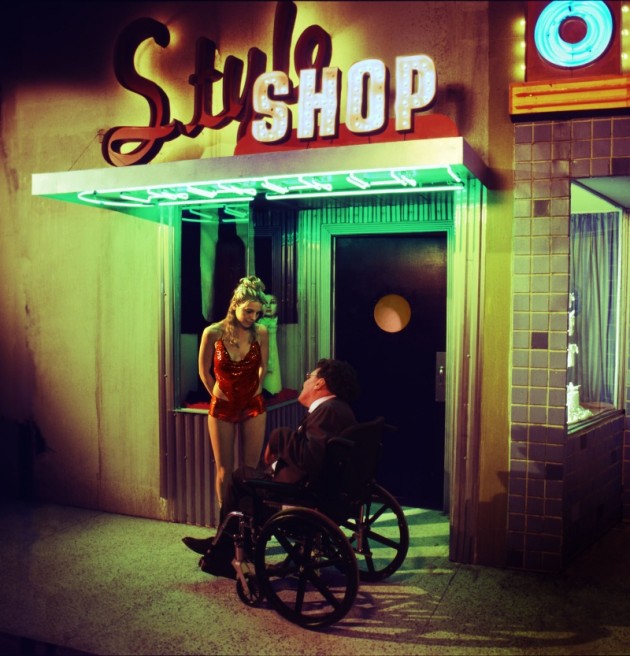
Girl on the Street
The final victim is April Hoglund as the “Girl in the Nursing Home,” a young attractive woman with a prosthetic knee brace. The final two deaths are paired visually through the stylized apartment complex set which captures both apartments and the hallway between them by exposing the walls. As Paul moves over to join April in her apartment the camera frames the whole space from far and we see Julie inert in the bath tub and April in her across the way apartment. This sex scene between April and Paul is different from all the others because it is far more explicit, and seems in fact non-simulated. April fellates Paul then positions herself on top directing her body onto Paul’s erect penis. This final sex/murder scene is a culmination of the bizarre nature of the sex/murder scenes where the women either do not struggle or only half-heartedly resist Paul’s advances. It also seems highly improbable that Paul would have the strength to so easily overwhelm these young, in most cases fit, women. The sex scene with April is also a culmination of Paul’s sexualized murder fantasy because April tells Paul to strangle her while he is inside her. Shifting from at most simulated sex to this hard core sex scene is jarring to say the least. After this final kill the film cuts back to the opening shot of the film in the nursing home, which relates to any audience member who may not have figured it out already, that the events they have been seeing are part of Paul’s psycho-sexual fantasy. I for one was happy with this narrative ‘twist’, since it shifts the misogynistic acts from fictive reality to fictive fantasy. In short, it allows Glover and Stewart to “have their cake and eat it too”.
Seen as a psycho-sexual fantasy we can chart a meaningful evolution in the deaths. The first murder is of a middle-aged woman who is fully dressed. No sex is performed. It is a ‘chaste’ killing. By the final murder, the sex is “real” and sex and death are fused together to complete Paul’s psycho-sexual fantasy journey: April asks to be killed with Paul’s erect penis inside her vagina. Since the film ends up being a fantasy projection one can speculate as to the real nature of what the fantasy means. As a man who suffered abuse and dehumanization for years, would Steven C. Stewart find retribution in the killing of women? One would think the answer here is clearly no. Instead the fantasy informs other missed or stilted desires. For example, simply being heard and listened to is a victory for Steven/Paul. If the people at the nursing home would have just taken the time and effort to actually understand Stewart’s words and feelings they would not have condemned him to the condition of a mentally challenged person. So why, with Paul’s (and Steven’s) speech impediment, dysarthria, do all the women in the film understand him perfectly? Well it is part of the fantasy: to be understood. That several much younger and attractive women find Paul interesting and attractive is an obvious enough fantasy. But the murdering of the women can be read simply as a form of empowerment, not necessarily over women but ALL the people who lorded over him during his ten year residency at the nursing home.
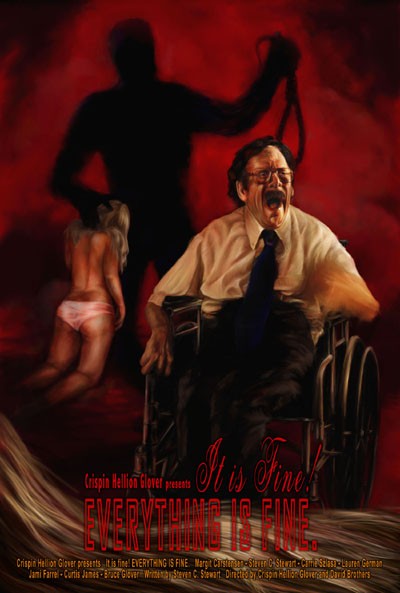
Poster modelled after Francis Bacon. Stewart’s primal scream has a precedence

Francis Bacon’s 1953 “Study After Velazquez’s Portrait of Pope Innocent X”
The fantasy aspect is cemented by the stagey mountain scene where Paul is holding onto the long hair of a Rapunzel-like damsel and then falls backward off the mountain after the hair keeping him up is snipped off. The scene is a recreation of the German fairytale Rapunzel, while also referencing the German mountain films and perhaps even Guy Maddin’s own Mountain film pastiche, Careful.
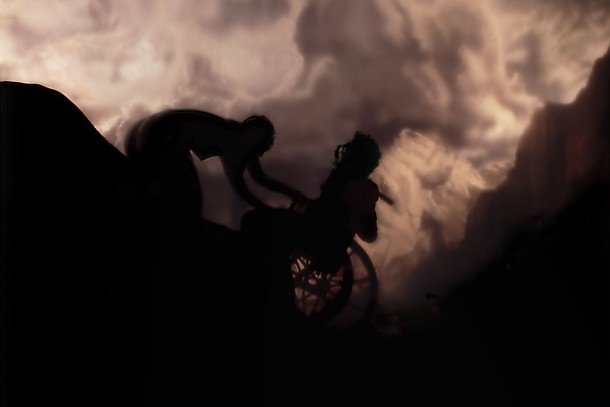
Mountain Scene modelled after Maddin’s Careful?

Careful
After the wrap around we find Paul back at the nursing room, in a cramped sleeping quarter with two other residences. Paul looks intently at the photographs on his night table, one of his younger self with his mother and another of just his mother. The film ends on a close-up image of his mother’s photograph. This ending reminded me (as did some other parts of the film and its overall subject) of the end of The Elephant Man, where John Merrick organizes a little sanctuary around his bed moments before he has decided to “sleep normally” by removing the many pillows he sleeps on that enable him to breathe, in effect a suicide (Lynch here is exercising creative license since there is no indication that Merrick committed suicide). The center piece of Merrick’s sanctuary is the two photographs of his mother on his night table, one of which ends up transforming into a ghostly image of her mother hovering in the darkness of outer space. I asked Glover during the signing session if he had that scene in mind and he said that he had not consciously thought of it but that he could see the similarities after I brought it to his attention. The two finales resonate because they both culminate in a redemptive death. Merrick dies during his sleep, after attending the opera for the first time and completing his replica of the Mainz cathedral. While we learn in a final title card that Steven C. Stewart died about a month after the film. Sadly, Stewart never saw the finished film.
The Rapunzel-styled scene also holds psychological symbolism: the hair as an umbilical cord which Paul must sever to start life anew. Unfortunately, Steven died shortly after the film, making it a legacy film, a film Steven needed to make to leave something behind as his greatest accomplishment. Like John Merrick, who in his death scene signs his name to the miniature replica of the Mainz cathedral that he created and will be part of his legacy. Like Merrick, Stewart has risen in his death from an exploited product to a creator of art.
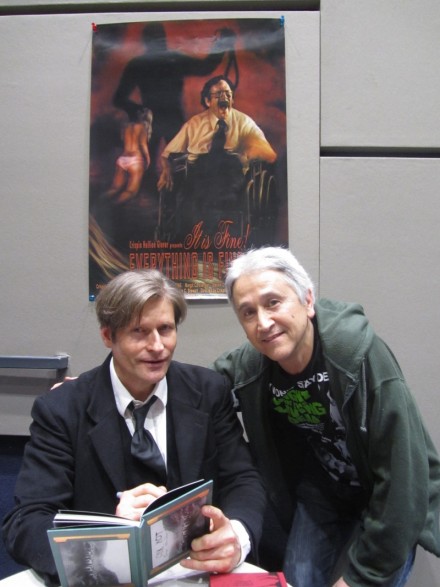
Author with Glover (left)
Note: All images are from the film or production stills taken from Glover’s website: http://www.crispinglover.com/



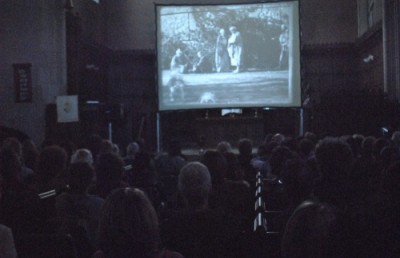
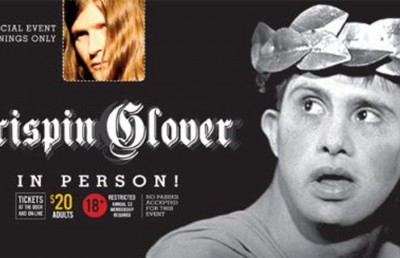

_400_258_90_s_c1.jpg)







